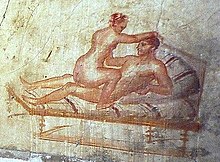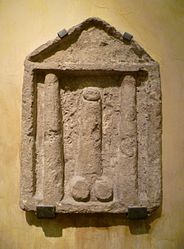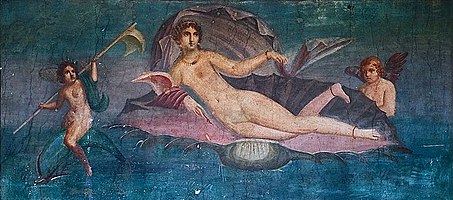User:Imwhited/sandbox
Outline[edit]
I plan to use more sections regarding different major pieces of art that were made at this time. Biographies and other pieces of artwork will be shown including their backgrounds, origin, and purposes. If this page had more artwork and background it would make it much more interesting to the visiting audience. So far, I find some of the work presented to be fairly interesting but I know there is more out there. Im in need of more sources and I believe that the library is where I will find myself looking for such work compared to what I can find on the internet. The internet has fairly some information but not enough that I would prefer to have. Once more sources are gathered, I will be able to execute the demonstration of the unpopular artwork that needs to have attention and could easily be found here on Wikipedia.
Article Evaluation:[edit]
https://en.wikipedia.org/wiki/Hellenistic_art The article was relevant and full of information. Article may be bias but only because it is supported with factual information. The sources are efficient and useful.
Sources[edit]
I plan to contribute more efficient research and scholarly articles based on the selected article available. Seems like an unusual concept for myself to get interested in but it was another time and erotic art is art. https://en.wikipedia.org/wiki/Erotic_art_in_Pompeii_and_Herculaneum List of sources regarding selected article https://search.proquest.com/openview/0f973002f808d8f48efcf7bb9e257fac/1?pq-origsite=gscholar&cbl=40583 http://www.jstor.org/stable/41318441?seq=1#page_scan_tab_contents http://www.tandfonline.com/doi/abs/10.1179/msi.2008.3.1.29
Erotic art in Pompeii and Herculaneum[edit]

Erotic art in Pompeii and Herculaneum has been both exhibited as art and censored as pornography. The Roman cities around the bay of Naples were destroyed by the eruption of Mount Vesuvius in 79 AD, thereby preserving their buildings and artifacts until extensive archaeological excavations began in the 18th century. These digs revealed the cities to be rich in erotic artifacts such as statues, frescoes, and household items decorated with sexual themes. The ubiquity of such imagery and items indicates that the treatment of sexuality in ancient Rome was more relaxed than current Western culture. (However, much of what might strike modern viewers as erotic imagery (e.g. oversized phalluses) could arguably be fertility imagery.) This clash of cultures led to a large number of erotic artifacts from Pompeii being locked away from the public for nearly 200 years.
In 1819, when King Francis I of Naples visited the Pompeii exhibition at the Naples National Archaeological Museum with his wife and daughter, he was embarrassed by the erotic artwork and ordered it to be locked away in a "secret cabinet", accessible only to "people of mature age and respected morals". Re-opened, closed, re-opened again and then closed again for nearly 100 years, the Secret Museum, Naples was briefly made accessible at the end of the 1960s (the time of the sexual revolution) and was finally re-opened for viewing in 2000. Minors are still only allowed entry to the once-secret cabinet in the presence of a guardian, or with written permission.
Examples[edit]
Phalluses[edit]
-
Phallus relief from Pompeii, c.1-50 AD
-
Bronze 'flying phallus' amulet (1stC BC)
The phallus (the erect penis), whether on Pan, Priapus or a similar deity, or on its own, was a common image. It was not seen as threatening or even necessarily erotic, but as a ward against the evil eye.[citation needed]. The phallus was sculpted in bronze as tintinnabula (wind chimes). Phallus-animals were common household items. Note the child on one of the wind chimes.
Priapus[edit]
-
Wall mural of Mercury/Priapus
-
Wall Painting of Priapus, House of the Vetti
A wall fresco which depicted Priapus, the god of sex and fertility, with his oversized erection, was covered with plaster (and, as Karl Schefold explains (p. 134), even the older reproduction below was locked away "out of prudishness" and only opened on request) and only rediscovered in 1998 due to rainfall.[1]
The second image, from Schefold, Karl: Vergessenes Pompeji: Unveröffentlichte Bilder römischer Wanddekorationen in geschichtlicher Folge. München 1962., with its much more brilliant colors, has been used to retouch the younger, higher resolution image here.
Venus[edit]
-
Mural of Venus
The mural of Venus from Pompeii was never seen by Botticelli, the painter of The Birth of Venus, but may have been a Roman copy of the then famous painting by Apelles which Lucian mentioned.
Statue of Aphrodite[edit]

This piece of art demonstrated the Greek goddess of love, Aphrodite. The statuette comes from the property of Julia Felix, who is an entrepreneur that advertised a fiver-year lease on a piece of her holdings.The Aphrodite was found in a complex that may have been a brothel, judging by its graffiti and other evidence found. Aphrodite was a goddess of marriage and family life but by a reference to her in a regulation of Solon, the name also became associated with prostitution, and in subsequent years, Aphrodite was worshipped as the goddess of love. She is occasionally depicted emerging from the sea or leaving a bath but in this piece she is just adding a sandal aided by ErosEros who holds her foot, and by a Priapus on whom she leans on.[2]
Lovers on the Couch[edit]
This unique couple occupy a couch which was primarily used for dining, but could also be used to make love. He reclines on his left arm in a manner thats customary while drinking wine, which he pours from a rhyton. She wears a diaphanous gown and appears to be observing the wine effects on him. At the appropriate time, she waits until the attendant brings her something. The servant girl looks at her and holds the box that was summoned by her mistress. A well proportioned three legged table bears other ingredients, which will be taken separately or mixed with the wine. These included herbs and possibly an aphrodisiac.[2]

Locations[edit]
House of the Vettii[edit]


The House of the Vettii was not a Lupanar (Pompeii) or a brothel. It was a private villa richly decorated with mythological wall paintings owned by two wealthy men. In addition, the villas kitchen has a small room with a purpose to provide entertainment for guests. The small room included erotic scenes that represent a small fraction of the hundreds of wall paintings that have been recovered in over two centuries of excavation in the region of Naples, which was frozen in time under the great eruption of Mount Vesuvius. Many of these erotic scenes tend to turn up more commonly than imaginable today on pottery and other works of art. Few paintings in general and fewer erotic scenes survive from Rome, yet statistical proportions of extant works remain to be misleading. These pictures have ben conspicuous due to their absence from general works on Roman wall painting. These erotic scenes in the paintings are nothing but one expression of the extent to which desire had become feminized and domesticated in first-century Rome. [3]
Exhibitions[edit]
- March 28 to September 29, 2013 at The British Museum
- Naples Secret Museum with a two century closing Haitus later re-opened in 2000.:http://www.museoarcheologiconapoli.it/en/
Notes[edit]
Bibliography[edit]
- Feder, T. H. (1978). Great Treasure of Pompeii & Herculaneum . New York , NY: Abbeville Press.Clarke, John (2003). Roman Sex: 100 B.C. to A.D. 250. New York: Harry N. Abrams. ISBN 9781626548800.
- Grant, Michael; Mulas, Antonia (1997). Eros in Pompeii: The Erotic Art Collection of the Museum of Naples. New York: Stewart, Tabori and Chang. ISBN 978-1556706202.
- McGinn, Thomas A.J. (2004). The Economy of Prostitution in the Roman World. Ann Arbor: The University of Michigan Press. ISBN 9780472113620.
- Richlin, A. (n.d.). Pornography and Representation in Greece & Rome . New York , NY: Oxford University Press.Varone, Antonio (2001). Eroticism in Pompeii. J. Paul Getty Museum. ISBN 9780892366286.
{{cite book}}:|work=ignored (help)
External links[edit]
- Owen, Richard (27 October 2006). "Erotic frescoes put Pompeii brothel on the tourist map". The Times.
{{cite news}}: Unknown parameter|subscription=ignored (|url-access=suggested) (help)





